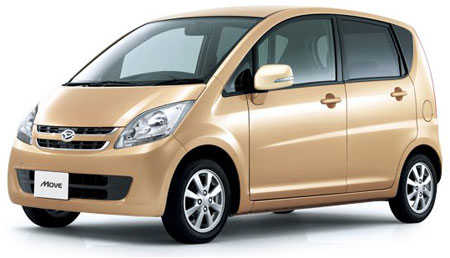Japanese small car manufacturer Daihatsu has managed to triumph over its much larger cousin Toyota as far as non-hybrid passenger cars on the Japanese market are concerned. The company’s small car, called the Move, burns as little as 3.7 liters of fuel every 100 kilometers (63 mpg), while Toyota only manages 3.77 l/100 km with its redesigned Vitz, which will be released later this month.
Daihatsu said fuel efficiency improved to the 27km/litre mark, the highest achieved using the Japanese test cycle, through measures including the adoption of a newly developed idle-stop system called 'eco idle', an updated second-generation KF engine and an approximate 35kg (77lbs) reduction in weight. According to the manufacturer, stopping the engine automatically to save fuel when the car stops improves fuel efficiency by 2km/liter.
The small Japanese manufacturer says that it is the first company to combine idle-stop with a CVT transmission without an electric oil sump. The systems also include an auxiliary power unit, preventing problems such as the resetting of the navigation system once the engine is stopped, a Japanese market first according to just-auto online publication.
Other weight savings were achieved by the usage of a plastic electronic throttle body and the CVT gearbox, which also provides optimal power delivery while saving fuel. The flash memory navigation system fitted to the model is also equipped with an eco-driving function, providing Japanese motorists with the optimal fuel-efficient driving on the basis of driving condition analysis, and an energy-saving route search feature that recommends the most fuel-efficient route to the destination.
As gas prices are on a steady rise again, the competition to build the most fuel-efficient car possible will undoubtedly increase in Japan.
Daihatsu said fuel efficiency improved to the 27km/litre mark, the highest achieved using the Japanese test cycle, through measures including the adoption of a newly developed idle-stop system called 'eco idle', an updated second-generation KF engine and an approximate 35kg (77lbs) reduction in weight. According to the manufacturer, stopping the engine automatically to save fuel when the car stops improves fuel efficiency by 2km/liter.
The small Japanese manufacturer says that it is the first company to combine idle-stop with a CVT transmission without an electric oil sump. The systems also include an auxiliary power unit, preventing problems such as the resetting of the navigation system once the engine is stopped, a Japanese market first according to just-auto online publication.
Other weight savings were achieved by the usage of a plastic electronic throttle body and the CVT gearbox, which also provides optimal power delivery while saving fuel. The flash memory navigation system fitted to the model is also equipped with an eco-driving function, providing Japanese motorists with the optimal fuel-efficient driving on the basis of driving condition analysis, and an energy-saving route search feature that recommends the most fuel-efficient route to the destination.
As gas prices are on a steady rise again, the competition to build the most fuel-efficient car possible will undoubtedly increase in Japan.

